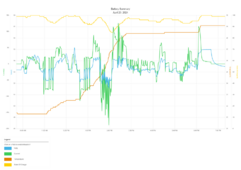This is a trace from this weekend's test. From 10:00 to 1:30 the graph shows string 3 running and string 2 cycling on and off to supply the load from my dryer and other heavy loads. Even with this 5000 watt load running, it can keep the battery between 94 and 100% SOC. The dryer is not a steady load. It cycles on and off to maintain a certain temperature. I wanted to be able to test what would happen with all three strings running. The PV was keeping up even with my large loads, so I turned all the PV breakers off. From 1:30 to 2:15 of the trace here shows running the dryer and oven with all the PV circuits turned off. This was so I could deplete the battery below 90%. This is required to get the third string to turn on. Then at 2:15 to 2:45 all 3 strings are turned on when I turned the PV breakers back on. All three strings were running and the battery charged back up quickly. From 2:45 to 6:00 the graph again shows string 3 running and string 2 cycling on and off to maintain a more steady state condition after all the big loads were finished. The last current spike around 6:00 PM is from turning the grid back on and the resulting charge cycle.
Pushing large amounts of current in and out of the battery does cause them to heat up a little, but the voltage and the SOC stay well controlled despite large swings in current. Once the batteries were charged up, the PV shedding occurred. Then when the system was maintaining a more steady state and not running huge loads, the batteries were no longer heating up. Also, the SOC is maintained at a fairly high level. Sol Arc recommends setting their system up so AC coupling will turn on at 80% and off at 90%. This means that you could go into the night time at only 80% charge if your timing is bad. If you reserve 10% to prevent an unrecoverable "black start" during an outage, you would have only 70% usable charge or 10.5 KWHs going into the night.
Ideally, I would still like to be at 6 batteries rather than 3, but I am calling this a success. Running over night assuming conservative power usage should be fine with this setup. If an outage occurs in summer, I should be fine to run the A/C until around 7:00 PM. I might program the thermostat to "Pre-cool" the house the last 3-4 hours of the day and then turn the A/C off between 7 PM and 7 AM. The running watts on my A/C is around 2000 Watts so it is no problem running it while sunny. My house should stay cool enough overnight in PA given our climate. With 6 batteries, I probably wouldn't need to change anything.
In the winter, with only 8 hours of generation, I might use 8 KWHs overnight just for idle consumption. So useable capacity should be around 15K * 0.85 = 12.75 KWH. I should be able to make it through the 16 hour night, but I will need to supplement once a day with a generator when it is cloudy. If I charge the batteries up every evening when they are low, I should be fine. Being able to keep the battery more fully charged is almost like getting another 1/2 of a battery usable. If I had 6 batteries, the Sol Arc charging model would mean I could lose pretty much an entire battery of usable charge each night.




